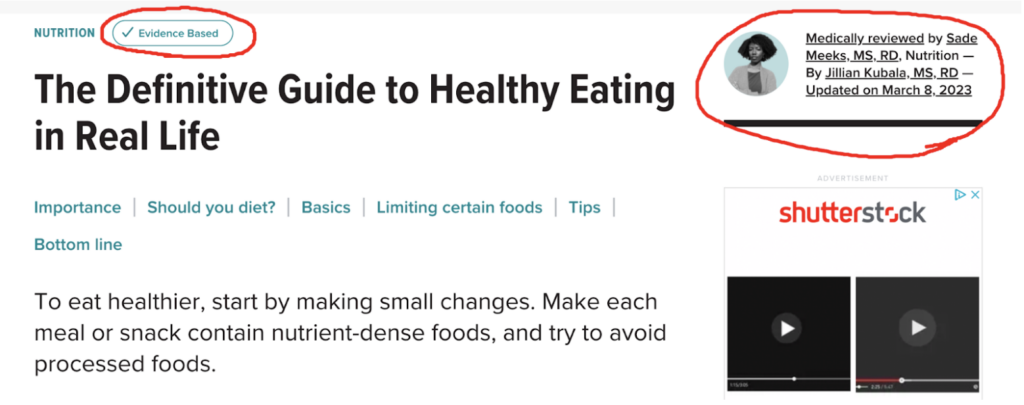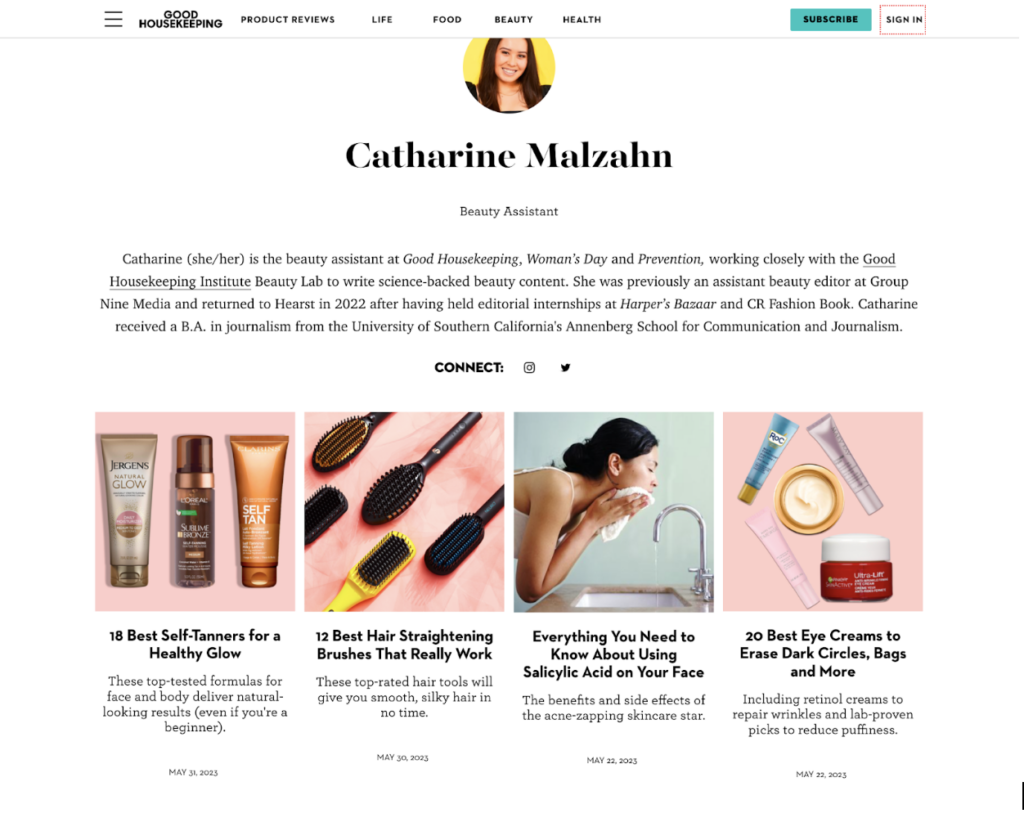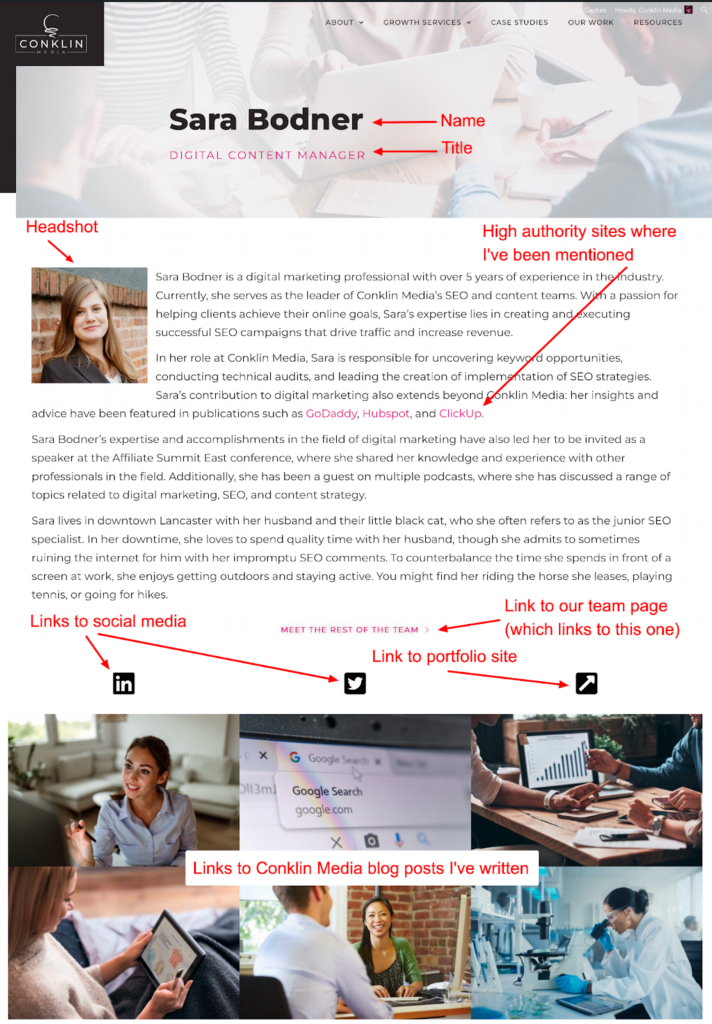A few months ago, my husband was planning an itinerary for a trip to Boston. Like many of us, he turned to Google. As he clicked through the top search results for “things to do in Boston”, his frustration grew with every repetitive suggestion.
“They all say the same thing. Everyone mentions the exact same landmarks and restaurants. How am I supposed to know who’s actually been there, and who’s just writing for SEO?”
(He asks me this question every time he Googles something now)
Maybe you feel the same way about search results. Maybe your customers do, too.
Google knows this. Gone are the days when the search engine could be “gamed” with keyword stuffing and other SEO tricks.
Content should always be written for your readers first. While this has always been the case, there’s long been a balance between writing for the search engine and writing for the reader.
The best way to ensure your content is created for readers? Incorporating EEAT.
What Is EEAT?
EEAT stands for Experience, Expertise, Authoritativeness, and Trustworthiness. It is a set of criteria that Google uses to evaluate the quality of websites and the content on them. Websites that demonstrate high levels of EEAT are more likely to rank well in Google’s search results because Google recognizes them as good resources that know what they’re talking about.
Experience: In a world of rehashed and over-optimized content, websites that are created by people who have firsthand experience in the topic they are writing about stand out. In EEAT, experience refers to the content creator’s or website’s first-hand or life experience relating to the topic. This could include things like working in the industry, having a personal connection to the topic, or simply being a lifelong learner who has accumulated a wealth of knowledge over time. Giving specific examples and incorporating anecdotes goes a long way.
Expertise: Google also places importance on websites and content that are written by experts in the field. This means that the author should have a deep understanding of the topic and be able to communicate that knowledge in a clear and concise way. This could be demonstrated through things like formal education, certifications, publications, or other evidence of specialized knowledge. Demonstrating expertise goes beyond firsthand experience – writers should incorporate what their experiences have taught them that would be helpful to others. A biography can help show this expertise.
Authoritativeness: You may have noticed that many of the most highly ranking websites and articles are published by authoritative sources. This means that the website should have a good reputation online and be well-respected by others. The content should also be well-written and not contain any grammatical or factual errors. Backlinks will also play a role here. What kinds of sites are linking back to the website?
Trustworthiness: Google values websites and content that are trustworthy. This means that the website should be transparent about its ownership and funding. The content should also be objective and unbiased.
Reputation Management: Doing EEAT Before It Was Cool
Not to sound like a hipster, but I did EEAT before it was cool.
I started my career in reputation management, which today I describe as marketing’s weird cousin. There was a lot of overlap between reputation management and marketing as we know it: I got a crash course in branding, design, social media management, content creation, and SEO. SEO very quickly became hands-down my favorite part, which is why I ultimately decided to move to an agency where I could focus primarily on that aspect.
Why do I mention this? Because so much of what I did then transfers over to improving EEAT for our team and our clients today. I mastered how to get profiles to rank quickly, build websites that Google recognized as authoritative, and overall create an online presence for people that transformed the way search engines (and other people) saw their expertise and personal brand.

Why Should You Care About EEAT?
In short: because Google cares. Quite a bit, actually. Since the search engine updated its algorithm in December, it seems that more priority is being given to sites with strong EEAT. It’s not the only important ranking factor, but it’s one that Google is weighing more heavily, and it looks like they’ll only consider it more important as time goes on.
Google has also recently announced that searchers can now filter search results by perspectives if it’s a topic that people might find beneficial to learn from others’ experiences. This is a helpful feature for topics that people might find beneficial to learn from the experiences of others. For example, if you’re starting a new lawn care business, you might want to learn how to do so from real people who have done the same, rather than just another listicle. Because of this, Google will show more content from Youtube, Reddit, personal blog posts, and articles that demonstrate real, human knowledge and experience.
Information quality and firsthand experience is going to be crucial if you want your content to show up here. What better way to demonstrate that experience and authority than by improving EEAT across your website?
How to Improve Your Site’s EEAT
If you want to be ahead of the curve when it comes to SEO, you need to start optimizing your site for EEAT now. I’ll be honest with you: it’s not going to be a short and easy process. But by taking action now, you’ll be setting yourself up for success in the long term as Google continues to prioritize high-quality, unique, and trustworthy content.
Create Quality Content
Gone are the days when all you had to do to rank was use your keywords as many times as possible in an article, or piggyback off of everyone else in the search results. We’ve ended up in a place where everyone’s rehashing the same piece of content over and over again.
Google’s well aware of this. They’re on to shady SEOs who use AI with reckless abandon and hacks like keyword-stuffing and sketchy backlink portfolios to get quick wins. In a content landscape ripe with content marketers prioritizing quantity over quality, Google’s changed the rules.
Quality is now the name of the game. They’re going to give priority to content that’s informative, accurate, and helpful! So much so that they rolled out the somewhat-unoriginally-named Helpful Content Update, and sites with lackluster content have taken a hit.
When you create your content, you need to consider quality above all else. Everything from ideation to grammar to images should be top-notch – your content should be something you’d be proud to share with the world.
Use Data and Cite Your Sources
Today, anyone can say anything at all and post it online. Google only wants to show the best, most relevant, most authoritative sites in search results. Make sure you make it clear where you’re getting your information, and link out to well-known and respected websites when you use data or stats.
Doing so lets Google know that you have the data to back up your claims, which helps build trust.
Make Sure You Have Expert Authorship (or Review)
Transparency is only going to become even more important. Google wants to know who’s writing what, so make sure you’re clear about who the author of an article is.
You can also mention if your content was reviewed by someone credible. We see this often on health websites, but it’s becoming more popular in other industries, too.

In this article by Healthline, for example, you can see that they have a section that displays who reviewed the article. They also have a button that reads “Evidence Based.” When users click into that button, they see a pop-up with a paragraph explaining what that means with links to the about page, offering information about the experts who write articles for the website.
Here’s another example from Good Housekeeping. At the beginning of this beauty article, you can see exactly who the author is. At the end, you can learn more about what makes her authoritative in this space. The short bio also includes a link to a longer about page, which links to her social media platforms and blog posts she’s written, building credibility.


Build Your Online Presence
Good, trustworthy content doesn’t exist in a vacuum. You need to make sure readers – and Google – can quickly find information about who you are and what you do. Ideally, everything about you that exists online should be linked together to make identifying you as easy and streamlined as possible.
This is one thing we focused quite a bit on for personal branding and reputation management. When someone searched for our clients, we wanted them to find a range of websites and platforms demonstrating their expertise. The more interconnected social media profiles and websites and guest posts were, the better.
Your SEO EEAT Checklist
Hopefully now you’re starting to understand more about what EEAT and why it’s going to be so important in the future of search results. Incorporating elements that signal expertise, experience, authority, and trust can be overwhelming, but there are some changes in particular that will be most impactful to start with. I’ve put together a checklist in a Google sheet you can make a copy of, and go into more detail about how to build out your EEAT below.
Create an Author Profile and Bio
I’m assuming that you have written some blog posts on your website. If not, well, there’s no time like the present! Putting out regular content lets Google know that you’re consistently sharing ideas (just like an expert in your field would!) and that your site has fresh content.
The first, and potentially fastest, step you can take to improve your EEAT is to add a short bio to your blog posts, highlighting your name, title, company, and credentials. This should also include a clear headshot and link to your about page. What about page? The one you’ll create following the directions below.
Build an About Page for Yourself
Your about page is going to be very important because it’s going to house information about you like a bio, links to social media, blog posts, and more on a website that Google closely associates with you – either your company’s website or your personal site, most likely.
Here’s one I created, and the different elements I included and why.

Name
What’s in a name?
When it comes to optimizing your site and profiles for EEAT, quite a bit! You’ll need to think of your name as your keyword, so you’ll be optimizing your content and social media profiles with that keyword in mind, much like you would for an article about a topic you want to rank for.
Because of this, it’s very important to keep your name consistent across any professional sites and social media profiles, as well as other places where you’re mentioned.
When I got married and changed my name, I had to update all of my profiles. Perhaps this is the case for you. Or maybe you’ve included middle initials, nicknames, etc in different places. You’ll need to go through and make sure everything is consistent across the board for the best results.
Yes, Google is getting “smarter” and better at connecting the dots between different name variations. But it’s not perfect, and I’d highly recommend taking the time to make sure everything is consistent – another lesson I learned during my time in reputation management!
Title
If your name is a keyword, think about your job title and workplace as secondary keywords that support your primary keyword. When working in reputation management, I found that Google seemed to prioritize results where people had their title or position and workplace incorporated into bios, title tags, and alt text.
This makes sense when we consider how Google “understands” meaning and assigns people, businesses, etc to different entities that are connected.
All that to say, it’s a good idea to mention your title in an H2 on your biography page. If there’s a place where you can make it seem natural to insert into the text as well, it’s likely worth doing.
If you ever change your title, you’ll want to make sure you’ve changed it on all relevant pages and platforms.
Images
Wherever you use images, it’s good to always follow best practices like compressing them and using appropriate naming conventions. Your name is your keyword, so make sure you include that in your picture’s title and alt text. You might also consider incorporating your title and workplace if it makes sense to do so.
Another thing I’d recommend is to use the same headshot across all your platforms. Like having a consistent approach with your name, title, and workplace, using the same image will ensure you’re making it crystal clear to Google what you want connected with your keywords.
This isn’t a one-size-fits-all approach, however. If you have a career that requires having a strong photo presence, it may be worth opting for using a variety of unique images instead of a consistent approach.
Your Bio
Your biography exists to further Google’s understanding of your expertise, so it’s important to strike a balance between optimization and highlighting some of the experiences that make you an expert in your industry. Here are a few things to consider incorporating:
- Years of experience
- Projects that set you apart in your industry
- Your location
- Any places you’ve been referenced (more on that later)
Since we’re optimizing your bio for your keyword but don’t want to make it seem keyword-stuffed, you should mention your name every 90-100 words. Any more than that, you’ll risk it being over-optimized or sound stilted and untrustworthy to real human viewers.
If you absolutely hate writing your own bio, you’re not alone. And if you want to have someone else do it, we can absolutely create you something that’s optimized and true to you.
Links to (and from) External Sites
If you’ve ever been mentioned on another website, you’re going to want to link to the page or post that mentions you. Ideally, where possible, you’re going to have that website link to your about page. By doing so, you’re giving Google a flashing golden arrow saying “this is me, this is what I do, this is what I’m good at.”
More on exactly how to do this later.
Links to Social Media
I used to describe creating a link structure to clients like this: you’re creating a web of interconnected websites, social media profiles, press mentions, and more. The more you’re able to connect all these together, the stronger Google’s understanding of who you are and what you do will be.
This sort of system also turns into a bit of self-fulfilling prophecy: the more likely others are to see profiles and content from you online, the more likely they’ll reach out to you about potential opportunities where you can demonstrate your authority. The more authoritative mentions you have, the more likely Google is to see you as an expert.
Connect to social media platforms wherever you can, whether it’s linking out on your about page, your personal portfolio site, websites where you’re mentioned and get an author bio, or even adding links on other social media profiles.
Internal Links
Don’t forget about internal links! If you’re mentioned anywhere on your website, make sure you use your name as the anchor text and link to your about page. You might add links to the leadership page, other articles you’ve authored, and posts you’ve reviewed as an expert. This helps Google better understand the website, as well as the role you play, while also reinforcing the quality of the content on your site by endorsing it with your expertise and experience.
Get Mentioned on Other Sites and Build Links to Build Authority
Getting other websites to link to your site and social media profiles is going to be one of the most important steps you can take to demonstrate authority. After all, Google (and real people) want to know that others in the industry think you’re credible. Even when you’re brilliant at what you do, it’s hard for search engines to understand that unless they see you mentioned in other places.
Unfortunately, finding these link placement opportunities is one of the most difficult aspects of the process. But here are a few ways you could get started:
- Ask to speak at events: Normally these include some type of online write up about you, your company, and your presentation.
- Reach out to industry sites: If you are a member of an association or simply an avid reader of a website, don’t be shy about reaching out and pitching some guest post ideas.
- Connect with others on LinkedIn: Social media is a great way to network and discover opportunities you didn’t know were out there.
- Write a press release: If you’ve done something newsworthy lately, you or your workplace could write a press release. If it’s relevant, news sources might pick it up and publish it.
- Sign up for a service like HARO: This is one of my favorite tactics. I’ve used it extensively and gotten some great links! Here’s an overview I wrote.
Another great option is to work with a media placement service. Our team can perform outreach and get you on high authority websites within your industry to improve your site’s EEAT.
Start Working on Your Site’s EEAT Now
EEAT is more than just a powerful tool that can help you improve your website’s ranking in search results: it’s going to be Google’s new standard. By following the tips in this article, you can start to build up your EEAT and improve your chances of being found by potential customers.
Of course, improving your EEAT is not a quick or easy process. EEAT is a long-term investment. It takes time to build up expertise, experience, authority, and trust on your website. But once you have a strong EEAT, you will be well-positioned to succeed in the online marketplace.
Remember, EEAT isn’t just about SEO: it’s also about building relationships with potential customers and clients. When people know that you are an expert in your field, they are more likely to do business with you because they feel confident that you know what you’re talking about and can help solve their problems.
EEAT is also an ongoing process. You need to continually work to improve your expertise, experience, authority, and trust. This means staying up-to-date on the latest trends in your industry, publishing high-quality content, and networking with other professionals.
At 5K, we’re committed to helping you crush your business goals. SEO is an excellent way to bring in more qualified leads and grow your revenue, but it’s evolving with every Google algorithm update.
If you’re not sure where to start, or if you need help improving your EEAT, we would be more than happy to develop a strategy that demonstrates your experience and expertise while signaling authority and trust.









